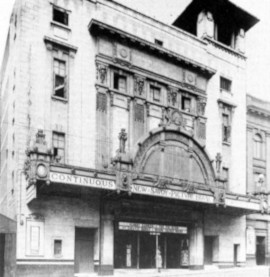Tony (Anthony) Paterson (TP-92-013)

The Savoy cinema, Glasgow (uploaded by elmorovivo). Creative Commons (Attribution) License via cinematreasures.org
In May 1992, Dr Tony (Anthony) Paterson responded to Annette Kuhn's call for 1930s cinemagoers in a local radio broadcast in Glasgow. Later that year he attended a screening event on 'Popular Cinema in the 1930s' at Glasgow Film Theatre and completed a short questionnaire. In 1994 he was contacted again with an invitation to take part in Cinema Culture in 1930s Britain, and was interviewed at his home in Glasgow's West End on 29 November 1994 as part of CCINTB's fieldwork pilot.
Born in 1920 in Newport, Fife, Dr Paterson had lived in Glasgow for most of his life. His father was a Lloyd's ship surveyor and his mother did office work before leaving paid employment to get married. He studied English at the University of Glasgow, and later took postgraduate degrees in Theatre Studies at the universities of Glasgow and Strathclyde. His occupations included school teaching and theatre administration, with posts at the Pitlochry Festival Theatre and at Glasgow's Citizens' Theatre. A keen film buff, Dr Paterson ranges widely over the cinema industry, films, film stars, and Glasgow cinemas in his interview. He recalls going to the pictures with his mother, an avid cinemagoer, from the age of five, and names some of the films he saw at the local cinemas he went to at the time. He takes a mental 'walking tour' of cinemas in Glasgow's city centre, complete with detailed descriptions of their architectural features and interior decor and of the facilities available at the grandest of them: orchestras, live acts and 'cine-variety', cafes with waitress service, ballrooms. He talks about the coming of sound and recalls a number of early talkies; and discusses British films of this period, noting that many were adapted from popular stage plays. He talks about his devotion to Jessie Matthews, expanding on her many talents and the difficulties she faced in her film career. He offers well-informed accounts of the place of actors in the Hollywood studio system, which offered career development and steady work. He details the launch of colour films, and draws aesthetic comparisons between colour and black-and-white films. More Hollywood stars and films are discussed, with biographical information and snippets of gossip. He enumerates his likes (musicals, gangster films, Norma Shearer, and Alice Faye) and dislikes (he regards Anna Neagle as overrated). He talks about film magazines and states his preference for 'Film Weekly', which he regards as more serious than the others. He recalls that he went to the cinema two or three times a week until the 1960s or 1970s, when he became more interested in theatre. He talks about his cinemagoing as a student and the makeshift outdoor film screenings he attended when he was on war service overseas. He still goes to the Glasgow Film Theatre occasionally, he says, but preferred it when it was still the Cosmo. He shows the interviewer his books about the Hollywood studios and his collection of film photos and postcards.Documents, Memorabilia and Related Links
Glasgow home pageThe Salon cinema (scottishcinemas.org.uk site)
Extract from 'The Little Foxes', 1941 (YouTube)
Extract of Lew Stone's Monseigneur Band (1933) (YouTube)